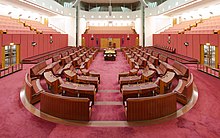
Back مجلس الشيوخ الأسترالي Arabic سێنای ئوسترالیا CKB Australischer Senat German Senado de Australia Spanish Senat (Austraalia) Estonian سنای استرالیا Persian Australian senaatti Finnish Sénat (Australie) French הסנאט האוסטרלי HE Senat Australia ID
Senate | |
|---|---|
| 47th Parliament of Australia | |
 | |
| Type | |
| Type | |
| Leadership | |
| Structure | |
| Seats | 76 |
 | |
Political groups | Government (26) Labor (26) |
Length of term | 6 years (state senators) 3 years (territory senators) |
| Elections | |
| Single transferable vote | |
Last election | 21 May 2022 (Half Senate election) |
Next election | 2024 or 2025 |
| Meeting place | |
 | |
| Senate Chamber Parliament House Canberra, Australian Capital Territory, Australia | |
| Website | |
| Senate | |
| This article is part of a series on the |
| Politics of Australia |
|---|
 |
| Constitution |
|
|
The Senate is the upper house of the bicameral Parliament of Australia, the lower house being the House of Representatives. The composition and powers of the Senate are established in Chapter I of the Constitution of Australia. There are a total of 76 senators: 12 are elected from each of the six Australian states regardless of population and 2 from each of the two self-governing internal Australian territories (the Australian Capital Territory and the Northern Territory). Senators are popularly elected under the single transferable vote system of proportional representation.
The Australian Senate is equal in power to the House of Representatives, except that it cannot originate or amend money bills (taxes or laws appropriating money) – only reject or defer them. This feature, closer to the strong bicameralism of the US senate, is not present in other comparable Westminster systems (such as the UK House of Lords) making the Australian system a unique hybrid, sometimes called a "Washminster mutation".[1][2][3]
Since 1948, the Senate has been elected using a proportional representation system with a much broader array of parties and independents represented in the chamber, with no individual party usually dominating. Following 1981, the government has only had a majority in the Senate from 2005–2007; otherwise, negotiations with other parties and independents have generally been necessary to pass legislation.[4]
Cite error: There are <ref group=lower-alpha> tags or {{efn}} templates on this page, but the references will not show without a {{reflist|group=lower-alpha}} template or {{notelist}} template (see the help page).
- ^ "How have the British and US systems of government influenced the Australian government system?". Parliamentary Education Office. Retrieved 5 December 2023.
- ^ Thompson, Elaine (1980). "The "Washminster" Mutation". Australian Journal of Political Science. 15 (2): 32–40. doi:10.1080/00323268008401755 – via Taylor & Francis Online.
- ^ Thompson, Elaine (2001). "The Constitution and the Australian System of Limited Government, Responsible Government and Representative Democracy: Revisiting the Washminster Mutation". University of New South Wales Law Journal. 24 (3) – via Austlii.
- ^ Williams, George; Brennan, Sean; Lynch, Andrew (2014). Blackshield and Williams Australian constitutional law and theory : commentary and materials (6th ed.). Annandale, NSW: Federation Press. p. 415. ISBN 9781862879188.
© MMXXIII Rich X Search. We shall prevail. All rights reserved. Rich X Search